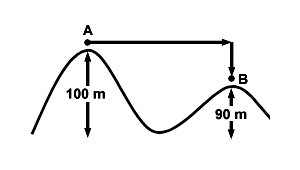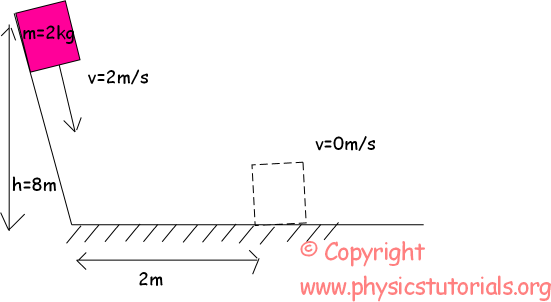Formula of Conservation of Energy:
- Ei = Ef
- KEi
+ PE
i= KEf + PEf
- ½ mv2i + mghi + ½ ks2i = ½ mv2f + mghf + ½ ks2f
- The SI unit is measured in joules (J).
- The American Unit is measured in calories.
The video explains the Law of Conservation of Energy. It shows how to use the formula in a problem and see what you are looking for. It gives an example of conservation of energy. It gives multiple examples and how you find what you are looking for. It explains how you use kinetic and potential energy. It shows you how you could find the potential and kinetic energy.
Example Problems:
1. A skier glides down a frictionless hill of 100 meters, the ascends another hill, of height 90 meters, as shown in the figure below. What is the speed of the skier when it reaches the top of the second hill?

The skier moves from point A to point B
The skier is in a conservative system, as the only force acting upon him is gravity. Instead of calculating the work done over the curved hills, we can construct an alternate path, because of the principle of path independence:

Theoretical Path of Skier
 mv f 2 = 10mg
mv f 2 = 10mg
We can cancel the mass and solve for v f :
v f =  = 14m/s
= 14m/s
 = 14m/s
= 14m/s
2. A block having mass 2kg and velocity 2m/s slide on the inclined plane. If the horizontal surface has friction constant µ=0, 4 find the distance it travels in horizontal before it stops.

We use conservation of energy in solution of this problem.
Einitial=Efinal
Einitial=Ep+Ek=mgh+1/2mv² Efinal=0
Einitial=2kg.10m/s².8m+1/2.2kg.
(2m/s) ² Work done by friction=Einitial
Einitial=164
J
Wfriction=µ.N.X=0,4.2kg.10m/s².X=Ei
8. X=164 J X=20,5m
Block slides 20,5m in horizontal
Screenshots of Roller Coaster:
The graph shows that the skater is at the beginning of the roller coaster. It has more potential energy because its at the top/its beginning.

The skater is at the bottom of the roller coaster. Whenever the skater is at the bottom its kinetic energy will be the greatest.
On this picture the skater is going around the loop. its kinetic energy is greater than potential energy because its on its way down the loop.


This comment has been removed by the author.
ReplyDeletevery nice work Jennie I'm glad you finished:)
ReplyDeleteThis comment has been removed by the author.
ReplyDeleteGreat job it looks awesome
ReplyDeleteHow does the video help find kinetic and potential energy better ?
ReplyDeleteThis blog did help me understand what happens when you go through a loop on a roller coaster.
ReplyDelete